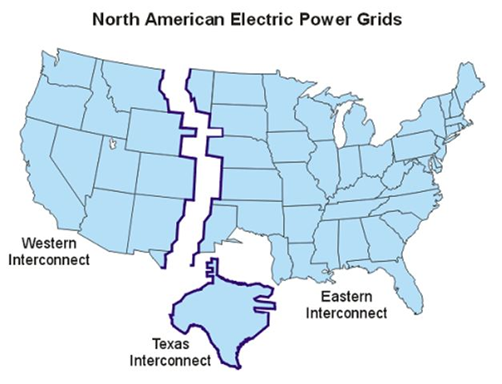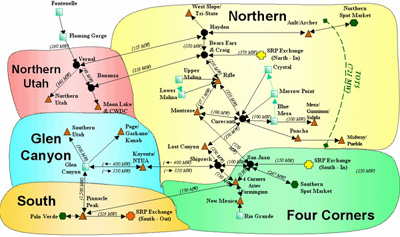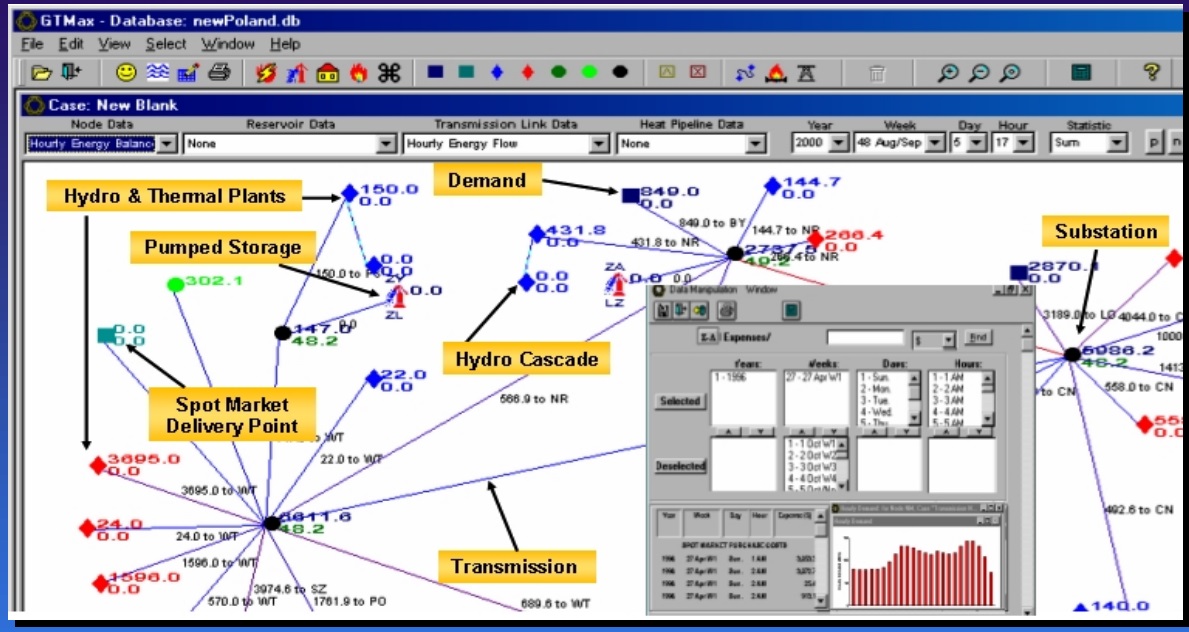Difference between revisions of "GCDAMP- GTMAX"
Cellsworth (Talk | contribs) |
Cellsworth (Talk | contribs) |
||
| (17 intermediate revisions by the same user not shown) | |||
| Line 17: | Line 17: | ||
</table> | </table> | ||
| − | [[Image: | + | [[Image:Gpp_map-electric-power-grid.png|center|400px]] <br> |
<!-- | <!-- | ||
| Line 24: | Line 24: | ||
|style="width:60%; font-size:120%;"| | |style="width:60%; font-size:120%;"| | ||
| + | WAPA and Reclamation uses Argonne's GTMax model to analyze the economics of CRSP hydropower systems in the western half of the U.S. power grid (the Western Interconnect). | ||
*GTMax stands for '''G'''eneration and '''T'''ransmission '''Max'''imization | *GTMax stands for '''G'''eneration and '''T'''ransmission '''Max'''imization | ||
| − | *GTMax: A model used to | + | *GTMax: A model used to guide operators in how to maximize the efficiency in scheduling generation to meet electrical loads. |
| − | + | ||
| − | + | ||
|}<!-- | |}<!-- | ||
| Line 41: | Line 40: | ||
|class="MainPageBG" style="width:55%; border:1px solid #cef2e0; background:#f5faff; vertical-align:top; color:#000;"| | |class="MainPageBG" style="width:55%; border:1px solid #cef2e0; background:#f5faff; vertical-align:top; color:#000;"| | ||
{|width="100%" cellpadding="2" cellspacing="5" style="vertical-align:top; background:#f5faff;" | {|width="100%" cellpadding="2" cellspacing="5" style="vertical-align:top; background:#f5faff;" | ||
| − | ! <h2 style="margin:0; background:#cedff2; font-size:120%; font-weight:bold; border:1px solid #a3bfb1; text-align:left; color:#000; padding:0.2em 0.4em;">'''Generation and Transmission Maximization (GTMax) Model'''</h2> | + | ! <h2 style="margin:0; background:#cedff2; font-size:120%; font-weight:bold; border:1px solid #a3bfb1; text-align:left; color:#000; padding:0.2em 0.4em;">'''Generation and Transmission Maximization (GTMax) Model '''</h2> |
|- | |- | ||
|style="color:#000;"| | |style="color:#000;"| | ||
| Line 52: | Line 51: | ||
The GTMax model helps researchers study complex marketing and system operational issues. With the aid of this comprehensive model, utility operators and managers can maximize the value of the electric system, taking into account not only its limited energy and transmission resources, but also firm contracts, independent power producer (IPP) agreements, and bulk power transaction opportunities on the spot market. GTMax maximizes net revenues of power systems by finding a solution that increases income while keeping expenses at a minimum. At the same time, the model ensures that market transactions and system operations remain within the physical and institutional limitations of the power system. When multiple systems are simulated, GTMax identifies utilities that can successfully compete in the market by tracking hourly energy transactions, costs, and revenues. | The GTMax model helps researchers study complex marketing and system operational issues. With the aid of this comprehensive model, utility operators and managers can maximize the value of the electric system, taking into account not only its limited energy and transmission resources, but also firm contracts, independent power producer (IPP) agreements, and bulk power transaction opportunities on the spot market. GTMax maximizes net revenues of power systems by finding a solution that increases income while keeping expenses at a minimum. At the same time, the model ensures that market transactions and system operations remain within the physical and institutional limitations of the power system. When multiple systems are simulated, GTMax identifies utilities that can successfully compete in the market by tracking hourly energy transactions, costs, and revenues. | ||
| + | |||
| + | [[Image:Ceeesa ModelsGtmaxRegions.jpg|center|600px]] <br> | ||
An added benefit of GTMax is that it simulates some limitations, including power plant seasonal capabilities, limited energy constraints, transmission capabilities, and terms specified in firm and IPP contracts. Moreover, GTMax also considers detailed operational limitations, such as power plant ramp rates and hydropower reservoir constraints. Currently, power companies are using GTMax to determine hourly, weekly, and seasonal power and energy offers to customers and to compute the costs of environmental legislation. GTMax can also be used to fine-tune hourly resource generation patterns, spot market transactions, energy interchanges, and power wheeling on the transmission system. | An added benefit of GTMax is that it simulates some limitations, including power plant seasonal capabilities, limited energy constraints, transmission capabilities, and terms specified in firm and IPP contracts. Moreover, GTMax also considers detailed operational limitations, such as power plant ramp rates and hydropower reservoir constraints. Currently, power companies are using GTMax to determine hourly, weekly, and seasonal power and energy offers to customers and to compute the costs of environmental legislation. GTMax can also be used to fine-tune hourly resource generation patterns, spot market transactions, energy interchanges, and power wheeling on the transmission system. | ||
| − | |||
| − | |||
An added value of the GTMax model is that it produces financial reports, which help dispatchers identify operational strategies to optimize the value of the system's resources, while continuing to take full advantage of market opportunities. The model also allows to define regions for added reporting capabilities as shown in the figure above. Data from GTMax are presented in easy-to-understand tables and graphs, providing information such as which units should be dispatched, how much power should be generated and sold on an hourly basis, when to buy and sell power on the spot market, the cost of alternative power plant operations, the incremental value of water, and the value of demand-side management programs. | An added value of the GTMax model is that it produces financial reports, which help dispatchers identify operational strategies to optimize the value of the system's resources, while continuing to take full advantage of market opportunities. The model also allows to define regions for added reporting capabilities as shown in the figure above. Data from GTMax are presented in easy-to-understand tables and graphs, providing information such as which units should be dispatched, how much power should be generated and sold on an hourly basis, when to buy and sell power on the spot market, the cost of alternative power plant operations, the incremental value of water, and the value of demand-side management programs. | ||
| Line 63: | Line 62: | ||
===GTMax example screen=== | ===GTMax example screen=== | ||
| − | The screen capture | + | The screen capture below shows the user-friendly geographical information system interface of GTMax. In this Windows-based environment, users can point and click on a map of utility power plants to modify input data and obtain optimization results, while simultaneously viewing two or more scenarios. Hourly energy flows from supply resources such as generators and IPP firm contract purchases to load centers and spot market delivery points are graphically displayed on a map. |
| + | |||
| + | [[Image:GTMAX- Screen-PIC.jpg|center|400px]] <br> | ||
===Issues Addressed by GTMax=== | ===Issues Addressed by GTMax=== | ||
| Line 127: | Line 128: | ||
Demo CD: You can request a CD that contains a 35-minute movie introducing you to the GTMax model if you contact CEEESA. | Demo CD: You can request a CD that contains a 35-minute movie introducing you to the GTMax model if you contact CEEESA. | ||
You can also contact our GTMax software distributor, ADICA Consulting LLC, to download the demo over the Internet. | You can also contact our GTMax software distributor, ADICA Consulting LLC, to download the demo over the Internet. | ||
| − | The full GTMax Professional software is licensed and distributed by Adica Consulting LLC. Please visit their website at www.adica.com for more details. | + | The full GTMax Professional software is licensed and distributed by Adica Consulting LLC. Please visit their website at www.adica.com for more details.[https://ceeesa.es.anl.gov/projects/Gtmax.html] |
|} | |} | ||
| Line 142: | Line 143: | ||
*[https://ceeesa.es.anl.gov/projects/Gtmax.html GTMax site at Argonne] | *[https://ceeesa.es.anl.gov/projects/Gtmax.html GTMax site at Argonne] | ||
| + | *[https://gcdamp.com/index.php/HYDROPOWER Hydropower page] | ||
| + | *[https://gcdamp.com/index.php/GCDAMP_SEAHG_Page SEAHG page] | ||
| + | *[https://gcdamp.com/index.php/SOCIOECONOMICS Socioeconomics page] | ||
|- | |- | ||
| − | ! <h2 style="margin:0; background:#cedff2; font-size:120%; font-weight:bold; border:1px solid #a3b0bf; text-align:left; color:#000; padding:0.2em 0.4em;"> | + | ! <h2 style="margin:0; background:#cedff2; font-size:120%; font-weight:bold; border:1px solid #a3b0bf; text-align:left; color:#000; padding:0.2em 0.4em;">2011 Hydropower KA and GT Max Model review workshop</h2> |
| − | + | ||
| − | + | ||
| − | + | ||
| − | + | ||
| − | + | ||
| − | + | ||
|- | |- | ||
|style="color:#000;"| | |style="color:#000;"| | ||
| Line 156: | Line 154: | ||
*[[Media:GTMax Rpt Final.pdf |GT Max Final Products of 2011 Hydropower KA and GT Max Model review workshop]] | *[[Media:GTMax Rpt Final.pdf |GT Max Final Products of 2011 Hydropower KA and GT Max Model review workshop]] | ||
*[https://www.usbr.gov/uc/progact/amp/amwg/2010-08-24-amwg-meeting/Attach_02a.pdf AMWG presentation: Socioeconomic Workshop and Panel Report] | *[https://www.usbr.gov/uc/progact/amp/amwg/2010-08-24-amwg-meeting/Attach_02a.pdf AMWG presentation: Socioeconomic Workshop and Panel Report] | ||
| − | + | *[https://www.usbr.gov/uc/progact/amp/pdfs/GTMaxModel/GTMax-Final-Rpt-main.pdf Final Report of the GTMax Model Review Panel] | |
| − | *[https://www.usbr.gov/uc/progact/amp/pdfs/GTMaxModel/GTMax-Final-Rpt-main.pdf | + | |
*[https://www.usbr.gov/uc/progact/amp/pdfs/GTMaxModel/Workshop-Particip-Resp.pdf Workshop participants' responses to the final report ] | *[https://www.usbr.gov/uc/progact/amp/pdfs/GTMaxModel/Workshop-Particip-Resp.pdf Workshop participants' responses to the final report ] | ||
*[https://www.usbr.gov/uc/progact/amp/pdfs/GTMaxModel/Expert-Panelists-Resp.pdf Panel's responses to workshop participants responses ] | *[https://www.usbr.gov/uc/progact/amp/pdfs/GTMaxModel/Expert-Panelists-Resp.pdf Panel's responses to workshop participants responses ] | ||
|- | |- | ||
| − | ! <h2 style="margin:0; background:#cedff2; font-size:120%; font-weight:bold; border:1px solid #a3b0bf; text-align:left; color:#000; padding:0.2em 0.4em;"> | + | ! <h2 style="margin:0; background:#cedff2; font-size:120%; font-weight:bold; border:1px solid #a3b0bf; text-align:left; color:#000; padding:0.2em 0.4em;">Does WAPA try to maximize revenues or minimize costs? </h2> |
|- | |- | ||
|style="color:#000;"| | |style="color:#000;"| | ||
| + | |||
| + | Excerpt from the [https://www.usbr.gov/uc/progact/amp/pdfs/GTMaxModel/Workshop-Particip-Resp.pdf workshop participants' responses] to the [https://www.usbr.gov/uc/progact/amp/pdfs/GTMaxModel/GTMax-Final-Rpt-main.pdf Final Report of the GTMax Model Review Panel:] | ||
In addition to numerous references to maximizing revenues and improving profits, the author(s) state | In addition to numerous references to maximizing revenues and improving profits, the author(s) state | ||
| Line 188: | Line 187: | ||
As in items 3-4 above, the promotion of false perceptions such as this serves only to establish or | As in items 3-4 above, the promotion of false perceptions such as this serves only to establish or | ||
strengthen barriers among AMP stakeholders who might otherwise be able to collaborate more | strengthen barriers among AMP stakeholders who might otherwise be able to collaborate more | ||
| − | effectively. [https://www.usbr.gov/uc/progact/amp/pdfs/GTMaxModel/Workshop-Particip-Resp.pdf] | + | effectively. [https://www.usbr.gov/uc/progact/amp/pdfs/GTMaxModel/Workshop-Particip-Resp.pdf ] |
| + | |||
Latest revision as of 09:02, 27 August 2024
|
|
WAPA and Reclamation uses Argonne's GTMax model to analyze the economics of CRSP hydropower systems in the western half of the U.S. power grid (the Western Interconnect).
|
| -- |
-- |
-- |
|---|
|
|


